hnRNPU-mediated pathogenic alternative splicing drives gastric cancer progression
- PMID: 39773744
- PMCID: PMC11705778
- DOI: 10.1186/s13046-024-03264-9
hnRNPU-mediated pathogenic alternative splicing drives gastric cancer progression
Abstract
Background: Alternative splicing (AS) is a process that facilitates the differential inclusion of exonic sequences from precursor messenger RNAs, significantly enhancing the diversity of the transcriptome and proteome. In cancer, pathogenic AS events are closely related to cancer progression. This study aims to investigate the role and regulatory mechanisms of AS in gastric cancer (GC).
Methods: We analyzed AS events in various tumor samples and identified hnRNPU as a key splicing factor in GC. The effects of hnRNPU on cancer progression were assessed through in vitro and in vivo experiments. Gene knockout models and the FTO inhibitor (meclofenamic acid) were used to validate the interaction between hnRNPU and FTO and their impact on AS.
Results: We found that hnRNPU serves as a key splicing factor in GC, and its high expression is associated with poor clinical prognosis. Genetic depletion of hnRNPU significantly reduced GC progression. Mechanistically, the m6A demethylase FTO interacts with hnRNPU transcripts, decreasing the m6A modification levels of hnRNPU, which leads to exon 14 skipping of the MET gene, thereby promoting GC progression. The FTO inhibitor meclofenamic acid effectively inhibited GC cell growth both in vitro and in vivo.
Conclusion: The FTO/hnRNPU axis induces aberrant exon skipping of MET, thereby promoting GC cell growth. Targeting the FTO/hnRNPU axis may interfere with abnormal AS events and provide a potential diagnostic and therapeutic strategy for GC.
Keywords: Alternative splicing; FTO; Gastric cancer; hnRNPU.
© 2024. The Author(s).
Conflict of interest statement
Declarations. Ethics approval and consent to participate: This study was approved by the Ethics Committee of China-US (Henan) Hormel Cancer Institute (Zhengzhou, Henan, China). The ethical review approval number was CUHCI2019082. Consent for publication: All authors agree to publish this manuscript. Competing interests: The authors declare no conflict of interest.
Figures


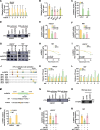
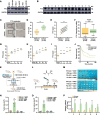
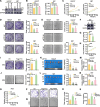

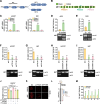

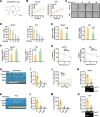
Similar articles
-
Alternative Splicing Factor Heterogeneous Nuclear Ribonucleoprotein U as a Promising Biomarker for Gastric Cancer Risk and Prognosis with Tumor-Promoting Properties.Am J Pathol. 2024 Jan;194(1):13-29. doi: 10.1016/j.ajpath.2023.10.007. Epub 2023 Nov 2. Am J Pathol. 2024. PMID: 37923250
-
Fat mass and obesity-associated protein (FTO) mediated m6A modification of circFAM192A promoted gastric cancer proliferation by suppressing SLC7A5 decay.Mol Biomed. 2024 Apr 1;5(1):11. doi: 10.1186/s43556-024-00172-4. Mol Biomed. 2024. PMID: 38556586 Free PMC article.
-
NONO regulates m5C modification and alternative splicing of PTEN mRNAs to drive gastric cancer progression.J Exp Clin Cancer Res. 2025 Mar 4;44(1):81. doi: 10.1186/s13046-024-03260-z. J Exp Clin Cancer Res. 2025. PMID: 40033337 Free PMC article.
-
Identification and validation of critical alternative splicing events and splicing factors in gastric cancer progression.J Cell Mol Med. 2020 Nov;24(21):12667-12680. doi: 10.1111/jcmm.15835. Epub 2020 Sep 16. J Cell Mol Med. 2020. PMID: 32939931 Free PMC article.
-
Alternative RNA splicing and gastric cancer.Mutat Res Rev Mutat Res. 2017 Jul;773:263-273. doi: 10.1016/j.mrrev.2016.07.011. Epub 2016 Jul 29. Mutat Res Rev Mutat Res. 2017. PMID: 28927534 Review.
Cited by
-
Transduction of Lentiviral Vectors and ADORA3 in HEK293T Cells Modulated in Gene Expression and Alternative Splicing.Int J Mol Sci. 2025 May 7;26(9):4431. doi: 10.3390/ijms26094431. Int J Mol Sci. 2025. PMID: 40362672 Free PMC article.
References
-
- Ajani JA, Lee J, Sano T, Janjigian YY, Fan D, Song S. Gastric adenocarcinoma. Nat Rev Dis Primers. 2017;3:17036. - PubMed
-
- Bray F, Laversanne M, Sung H, Ferlay J, Siegel RL, Soerjomataram I, et al. Global cancer statistics 2022: GLOBOCAN estimates of incidence and mortality worldwide for 36 cancers in 185 countries. CA Cancer J Clin. 2024;74(3):229–63. - PubMed
-
- Bonnal SC, Lopez-Oreja I, Valcarcel J. Roles and mechanisms of alternative splicing in cancer - implications for care. Nat Rev Clin Oncol. 2020;17(8):457–74. - PubMed
MeSH terms
Grants and funding
LinkOut - more resources
Full Text Sources
Medical
Research Materials
Miscellaneous

